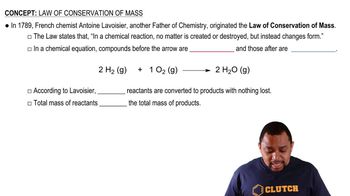(b) Menthol, the substance we can smell in mentholated cough drops, is composed of C, H, and O. A 0.1005-g sample of menthol is combusted, producing 0.2829 g of CO2 and 0.1159 g of H2O. What is the empirical formula for menthol? If menthol has a molar mass of 156 g/mol, what is its molecular formula?
An element X forms an iodide (XI3) and a chloride (XCl3). The iodide is quantitatively converted to the chloride when it is heated in a stream of chlorine: 2 XI3 + 3 Cl2 → 2 XCl3 + 3 I2 If 0.5000 g of XI3 is treated with chlorine, 0.2360 g of XCl3 is obtained. (a) Calculate the atomic weight of the element X. (b) Identify the element X.
 Verified step by step guidance
Verified step by step guidance
Verified Solution
Key Concepts
Stoichiometry

Molar Mass

Conservation of Mass

Nitrogen 1N22 and hydrogen 1H22 react to form ammonia 1NH32. Consider the mixture of N2 and H2 shown in the accompanying diagram. The blue spheres represent N, and the white ones represent H. (d) If so, how many of which type are left over?
How many N2 molecules are left over?
When a mixture of 10.0 g of acetylene (C2H2) and 10.0 g of oxygen (O2) is ignited, the resulting combustion reaction produces CO2 and H2O. (c) How many grams of CO2 and H2O are present after the reaction is complete?
Several brands of antacids use Al1OH23 to react with stomach acid, which contains primarily HCl: Al(OH)3(s) + HCl(aq) → AlCl3(aq) + H2O(l) (b) Calculate the number of grams of HCl that can react with 0.500 g of Al(OH)3. (c) Calculate the number of grams of AlCl3 and the number of grams of H2O formed when 0.500 g of Al(OH)3 reacts.
Write balanced chemical equations to correspond to each of the following descriptions: (d) When solid mercury(II) nitrate is heated, it decomposes to form solid mercury(II) oxide, gaseous nitrogen dioxide, and oxygen. (e) Copper metal reacts with hot concentrated sulfuric acid solution to form aqueous copper(II) sulfate, sulfur dioxide gas, and water.
Write balanced chemical equations to correspond to each of the following descriptions: (a) When sulfur trioxide gas reacts with water, a solution of sulfuric acid forms. (b) Boron sulfide, B2S3(s), reacts violently with water to form dissolved boric acid, H3BO3, and hydrogen sulfide gas.
